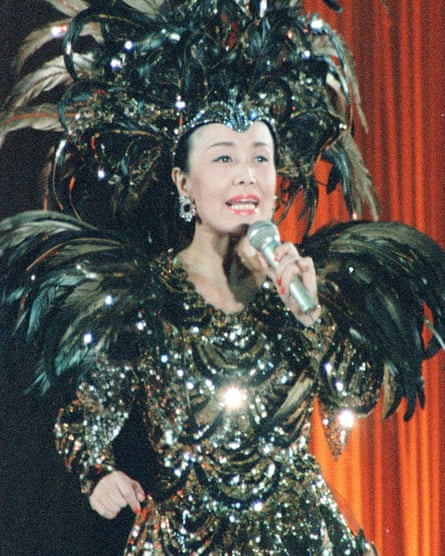Since her father is a longtime music journalist and her mother is a musician, it was inevitable that my 10-year-old daughter would fall in love with music. But I never imagined that the music she would fall in love with would be enka.
Enka is often considered “traditional” Japanese music – its early roots are in the 19th century and most enka singers dress in traditional kimonos. But modern enka was actually born in the postwar period of the late 1940s as Japan was learning about western music from the settling US troops. This so-called “traditional” Japanese genre is heavily influenced by jazz and the blues, country, and even rock, with intricate guitar lines fused with the stringed instruments shamisen and koto.
Over this incredibly diverse bed of influences, performers sing deeply emotional lyrics based on themes of loss, loneliness, despair, heartbreak and – just as often – celebration and joy. It’s a mishmash of dozens of kinds of music, and too dramatic to be called easy listening. Enka is enka. For readers in the west, the most obvious example would be Kaji Meiko, whose song The Flower of Carnage dramatically soundtracks the beheading of Lucy Liu’s character O-Ren Ishii in Kill Bill Vol 1.
My daughter listens to enka all day, every day. She’s had musical obsessions before, from western artists such as Selena Gomez and Abba to the godawful J-pop virtual boyband Strawberry Prince. But her love for enka and postwar “kayokyoku” songs has continued for well over a year, with no end in sight. Her favourite singer is Fuyumi Sakamoto. Now in her mid-50s, Sakamoto has been singing for 35 years, honing her voice to incredible sensitivity. Fuyumi-chan, as my daughter endearingly calls her, is capable of plumbing the depths of despair or scaling the heights of elation, always touching the listener’s heart. It goes without saying that her target audience is not children, but adults who have faced life’s hardships and survived.
My daughter sings Sakamoto’s songs at karaoke, practises her mannerisms, learns facts about her life. On learning that we and Sakamoto shared a mutual musician acquaintance, my daughter wrote her idol a gushing letter to pass along and received an autographed CD in return – which she now carries everywhere she goes. Her bedroom walls are covered in posters and magazine clippings of enka stars. She wants to be an enka singer when she grows up. It reminds me of me when I was about her age – only instead of posters of brooding young rock stars like Kurt Cobain, it’s all ladies in their 50s and 60s.
How did my daughter come to fall so heavily for a style of music that is generally made by and for seniors? We live in Tokyo and my daughter is half Japanese. Enka has always been in the mix on our home stereo – but then so has rock, punk, pop and dance. So why was it enka that stuck? “I like the lyrics of enka songs and the way the performers sing them,” my daughter explains. Although the themes of enka songs tend to be quite mature, she says she is able to relate to them: “The way the singers express the lyrics makes the deeper meanings easier to understand.”
Curiously, enka is finding ways to connect with younger audiences. Every year on New Year’s Eve in Japan, national broadcaster NHK produces a five-hour live music show in the countdown to midnight called Kohaku Uta Gassen – the 2022 edition was watched by about 20m households nationwide. The lineup is mostly made up of the year’s pop hits, but there is always a sprinkling of enka, meaning that younger generations are exposed to it whether they like it or not.
And during the pandemic, some enka stars, suddenly unable to perform for large groups of old folks, went online to reach their audience. Among them, megastar Sachiko Kobayashi – known as “Last Boss” because of her larger-than-life performances and insanely outlandish outfits akin to the often extravagant garb worn by the last bosses faced in many computer games – began her new career as a YouTuber, making meme-filled videos designed to appeal to a younger audience. And it worked – with videos where this high-class star makes fish-out-of-water visits to McDonald’s, tries a part-time job in a bakery, or undertakes the Mentos cola challenge with explosive results, Kobayashi’s channel has amassed 165,000 subscribers.
A few weeks ago, my wife and I took our daughter to see the 50th anniversary concert of top enka singer Sayuri Ishikawa. In a sea of seniors, my daughter was the only kid there. But Ishikawa surprised us all halfway through the concert by inviting the 46-year-old Japanese rapper Kreva on stage to perform a couple of songs together. Ishikawa has worked with Kreva before alongside tattooed rocker Miyavi, as well as alternative pop icon Sheena Ringo and ex-Megadeth guitarist Marty Friedman, but it was cool to see with our own eyes how enka is embracing more modern forms of music and adapting with the times.
My daughter has started to influence her classmates to listen to enka, and she encourages Guardian readers to check out Fuyumi Sakamoto, Sayuri Ishikawa and enka’s undisputed queen, the late Hibari Misora, for a starter education in this most uniquely Japanese genre of music. “I’ll listen to enka for the rest of my life,” she says – and I believe her.

